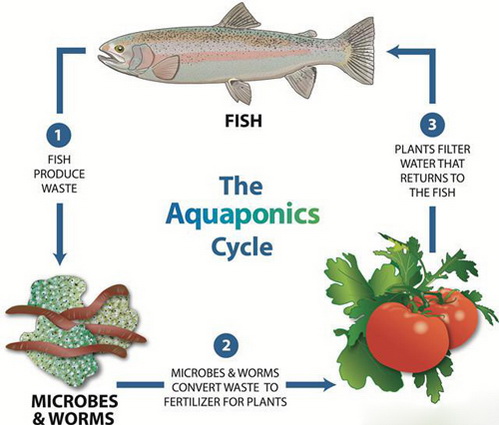Aquaponics is actually an ancient agricultural model. It carries on the ecological breeding and the planting through the aquatic animal and the aquatic plant linkage way. The feces produced by fish and shrimp decompose into dissolved ammonia, phosphorus fertilizer, potassium fertilizer and other substances under the action of microorganisms. These are the nutrients that plants need. Therefore, in a certain space, the coordination of animals, plants and microorganisms can be used to achieve a harmonious ecological balance among the three, which is a sustainable, recycling and zero-emission low-carbon production mode in the future.

The aquaponics system can be modified for large water bodies or for family aquarium tanks. The basic principles are the same. Generally speaking, there is a pump in the fish pond to raise the water to a certain height. The water containing nutrients (ammonia, nitrite, nitrate, phosphate, etc.) passes through the roots of the plants. The nutrients are absorbed by the plants and the water quality of the fish pond is purified. The two can work together to achieve long-term mutual benefit and good ecological effects. So the whole system includes fish pond, vegetable planting trough, vegetable fixed materials, water pump and so on. The key here is how to flexibly gRASp the proportion of a variety of nutritional elements. The last thing to be determined is to select suitable aquatic plants according to local conditions such as light and temperature. Determining THE AREA OF THE PLANT AND THE TOTAL BIOMASS (WEIGHT) OF THE AQUATIC ANIMALS SYNCHRONIZES THE NUTRIENT REQUIREMENTS OF THE PLANT WITH THE FERTILIZER EXCRETED BY THE AQUATIC ANIMALS.

According to the study, if the aquaculture portion of the aquaponics system is too dense, large areas of aquatic plants are required to support it. This will reduce the capacity per unit area. Therefore, the wastewater of aquaculture system can be filtered by certain equipment, such as microfilter, to separate most of the organic waste from the system. This will reduce the area of the plant. Improve the overall economic benefits. The concentrated organic waste can be fermented through fermentation tanks to produce green manure that can be sold to nearby farmers.

In the aquaponics symbiosis system, celery, lettuce, water cabbage and other varieties can be selected, which can be planted by the mode of foam floating board. You can also add a stone section. The crops were cultivated with the materials such as phytolith rich in trace elements. These materials have good water permeability and do not affect the absorption of ammonia and nitrate in the water, so they can fix the plants well and also be used as biological fillers. To facilitate the propagation of beneficial bacteria such as nitrifying bacteria. At THE same TIME, SOME trace elements contained in them can be slowly released into the system after the acidification of water in the late stage of circulating aquaculture system, which is beneficial to animals and plants in the system. There are also some granular filter material such as coral sand, the PH value of the system water quality has a strong regulating buffer effect.

Contact: Jack Lee
Phone: 13560241557
Tel: 020-22921925
Email: 1291544875@qq.com
Add: Guangdong guangzhou